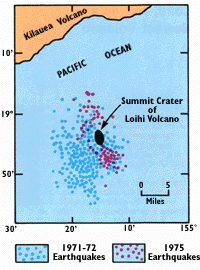Studies of Loihi provide a unique opportunity to decipher the youthful
submarine stage in the formation and evolution of Hawaiian volcanoes. When might
the still-growing Loihi emerge above the surface of the Pacific to become
Hawaii's newest volcano island? It will almost certainly take several tens of
thousands of years, if the growth rate for Loihi is comparable to that of other
Hawaiian volcanoes. It is also possible that Loihi will never emerge above sea
level and that the next link in the island chain has not yet begun to form.
 �
�
 �
�Above: Map showing the locations of earthquakes that occurred during 1971-72 and 1975 in the vicinity of Loihi. These two earthquake swarms, plus a similar occurrence in 1984-85, provide seismic evidence that Loihi is an active submarine volcano.
Left: The flank of Loihi, showing broken pillow lava of a fresh flow, as seen from about 7 feet above the volcano's surface at a water depth of about 4,200 feet. (Photograph by Alexander Malahoff, University of Hawaii.)
